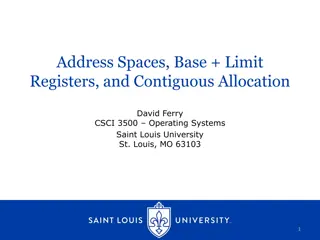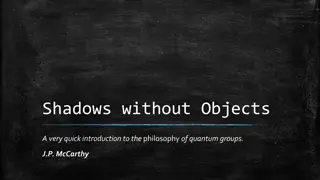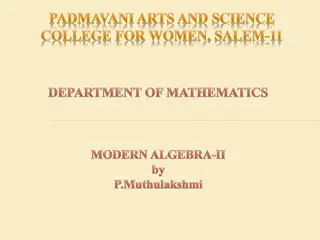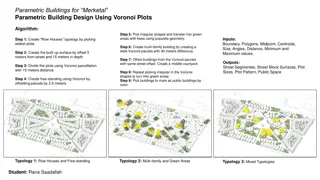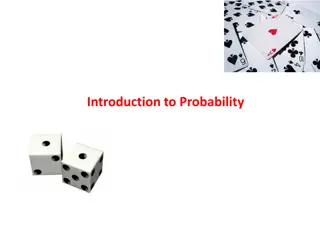Understanding Norming Properties in Banach Spaces
Exploring the concepts of small combinations of slices, the consequences of Hahn Banach Theorem, and the significance of Asplund Spaces and RNP in Banach spaces. Dive into the world of norming properties, separation theorems, and their applications.
Uploaded on Oct 04, 2024 | 0 Views
Download Presentation

Please find below an Image/Link to download the presentation.
The content on the website is provided AS IS for your information and personal use only. It may not be sold, licensed, or shared on other websites without obtaining consent from the author. Download presentation by click this link. If you encounter any issues during the download, it is possible that the publisher has removed the file from their server.
E N D
Presentation Transcript
ON SMALL COMBINATION OF SLICES IN BANACH SPACES Sudeshna Basu 1
CONSEQUENCE OF HAHN BANACH THEOREM A Closed bounded convex set, C in a Banach Space X, a point P outside, can be separated from C by a hyperplane 2
QUESTION : CAN THIS SEPARATION BE DONE BY INTERSECTION/UNION OF BALLS? IT TURNS OUT THIS QUESTION CAN BE ANSWERED IN VARYING DEGREE, IN TERMS OF ``NICE ( EXTREME POINTS IN SOME SENSE) POINTS IN THE DUAL UNIT BALL 3
Suppose , C X, D ? Let f ? , and >0 , then S( C, f, ) = { x C: f(x)> sup f(C) } is the open slice of C determined by f and . A point x C , is called denting if the family of open slices containing x forms a base for the norm topology at x( relative to C) If, D ? and the slices are determined by functionals from X, we have ? -slices and ? -denting points respectively. 4
Asplund Spaces and RNP X has RNP iff Radon Nikodym Property Iff every bounded closed convex set has a denting point X is an Asplund space iff all separable subspace of X has a separable dual. X is an Asplund space iff ? has RNP 5
ANP-I MIP ANP-II , ANP-II BGP PROP(II) ???? ANP -III NS ANP =Asymptotic Norming Property MIP= Mazur Intersection Property BGP= Ball generated Property NS= Nicely Smooth SCSP= Small Combination of Slices 6
Asymptotic Norming Properties ANP s were first introduced by James and Ho. The current version was introduced by Hu and Lin. Ball separation characterization were given by Chen and Lin. ANP II was introduced by Basu and Bandyopadhay which turned out to be equivalent to equivalent to Property(V) (Vlasov)( nested sequence of balls) It also turned out that ANP II was equivalent to well known Namioka-Phelps Property and ANP III was equivalent to Hahn Banach Smoothness which in turn grew out from the study of U subspaces. 7
X has ANP I if and only if for any w*-closed hyperplane, H in X** and any bounded convex set A in X** with dist(A,H) > 0 there exists a ball B** in X** with center in X such that A B** and B** H = 8
Characterization in terms of ?? X has ANP I if and only if all points of ?? are ? -denting points of ?? 9
X has MIP if every closed bounded convex set is the intersection of closed balls containing it. If and only if the ? -denting points of ?? are dense in ?? if and only if for any two disjoint bounded weak* closed convex sets ?1,?2in ? , there exist balls ?1,?2in ? with centers in X such that ?? ??, i = 1, 2 and ?1 ?2= .
X has ANP-II If and only if for any w* closed hyperplane H in X**, and any bounded convex set A in X** with dist (A,H) > 0 there exists balls B1**,B2** Bn** with centers in X such that A (UBi** ) and (UBi**) H = CO CO if and only if all points of ?? are w* -PC s of ?? i. e. (?? , w*) = (?? ,|| || ).
X has ANP III if and only if for any w*-closed hyperplane H in X** and x** in X** \H ,there exists a ball B** in X** with center in X the such that x** B**and B** H= if and only if all points of ?? are w*-w pc s of?? i.e. (?? , w*)= (?? , w)
X is said to have Property (II) if every closed bounded convex set is the intersection of closed convex hull of finite union of balls. If and only if the ? -PC s of ?? are dense in ?? if and only if for any two disjoint bounded weak* closed convex sets ?1, ?2in ? , there exist two families of disjoint balls in ? with centers in X, such that their convex hulls contain ?1, ?2and the intersection is empty
X has ANP II if and only if for any w* closed hyperplane H in X**, and any compact set A in X** with A H = , there exits a ball B** in X** with center in X such that A B** and B** H = If and only if all points of ?? are w*-strongly extreme points of ?? , i.e. all points of ?? are w*-w PC and extreme points of?? .
A point x* in a convex set K in X* is called a w*-SCS ( small combination of slices)point of K, if for every ?> 0,there exist w*-slices ??of K, and a convex ? ???such that x* S combination S = 1 and diam(S) <? 15
A bounded, convex set K X is called strongly regular if for every convex C contained in K and ?> 0 there are ?1, ..??of C such that diam ( 1 ? ??? )<? 16
SCS points were first introduced by N. Ghoussoub , G. Godefory , B. Maurey and W. Scachermeyer,as a ``slice generalisation" of the point of continuity points . They proved that X is strongly regular (respectively X is ? - strongly regular) every non empty bounded convex set K in X (respectively K in ? ) is contained in the norm closure (respectively ? -closure) of SCS(K)(respectively w-SCS(K)) i.e. the SCS points (w- SCS points) of K. 17
Later, Scachermeyer proved that a Banach space has Radon Nikodym Property (RNP) X is strongly regular and it has the KrienMilman Property(KMP). Subsequently, the concepts of SCS points was used by Rosenthal to investigate the structure of non dentable closed bounded convex sets in Banachspaces The "point version" of the results by Scachermeyer (i.e. charasterisation of RNP),was were proved by Hu and Lin . 18
Recently in 2015, Lopez Perez, Gurerra and Zocashowed that every Banach space containing isomorphic copies of ?0 can be equivalently renormed so that every nonempty relatively weakly open subset of its unit ball has diameter 2 (D-2Pproperty ) , however, the unit ball still contains slices of arbitrarily small diameter. There are several versions of D-2P properties and it will be interesting to explore the relations between several D-2P properties and the several density properties that arise from the SCS points. 19
X is said to have SCSP ( small combination of slices property) if ? = ???? (? -SCS points of ?? ) 20
X is said be nicely smooth if for any two points x** and y** in X** there are balls B 1** and B 2** with centers in X such that x** B1**and y** B2**and B1** B2** = . If and only if X* has no proper norming subspaces .
X is said to have the Ball Generated Property ( BGP) if every closed bounded convex set is ball generated i.e. it such set is an intersection of finite union of balls. BGP was introduced by Corson and Lindenstrauss . It was studied in great detail by Godefroy and Kalton. Chen, Hu and Lin gave some nice description of this property in terms of Combination of Slices Jimenez ,Moreno and Granero gave criterion for sequential continuity of spaces with BGP.
??stability P ( where P stands for any of the property defined the diagram earlier, except SCSP ) is stable under ?? sums The question is open for SCSP, more specifically a characterisation of ? -scs points in terms of the component spaces needs to be established. 23
?0-stability Most of these properties are stable under ?0 - sums except ANP-I,II, and MIP . Question is still open for SCSP i. e, how will the scs points be described in terms of the component spaces. 24
What happens in C(K,X)? It turns out that C(K,X) has P ( where P stands for any of the property defined the diagram, except SCSP ) if and only if X has P and K is finite. Stability of P under ?0 sums.( whenever that is true) The set A = { (k) ? : k K, ? ?? } a subset of the unit ball of the dual of C(K,X) turns out to be a norming set and does the job. P cannot be ANPI,II and MIP 25
C(K) For C(K) TFAE i)C(K) is Nicely Smooth ii) C(K) has BGP, iii) C(K) has SCSP, iv) C(K) has Property (II) v)K is finite. 26
L(X,Y) Suppose X and Y has P Does L(X,Y) have P? 27
What happens in L(X,Y)? L(X,C(K)) has P if and only if K(X C(K)) has P if and only if ? has P and k is finite. Stability of P under ?0 sums. The set A = { (k) ? : k K, x ??} turns out to be a norming set for L(X,C(K)) and does the job K(X (C(K))= C( K,? ) P cannot be ANP I, ANPII and MIP 28
?? (?,X) Let X be a Banach space, ? the Lebesgue measure on [0,1], and 1<p< . The following are equivalent a) ?? (?,X) has MIP b) ??(?,X) has II c) X has MIP and is Asplund. 29
?? (?,X) Let X be a Banach space, ? the Lebesgue measure on [0,1], and 1<p< . The following are equivalent a) ?? (?,X) has SCSP b) ??(?,X) has BGP c) ??(?,X) is nicely smooth d) X is nicely smooth and Asplund 30
TENSOR PRODUCTS If X Y i.e. the injective tensor product of X and Y has BGP(NS), then X and Y also has BGP(NS). 31
Converse If X and Y are Asplund, TFAE a) X and Y are nicely smooth b) X ?Y is nicely smooth c) X and Y has BGP d) X Y has BGP e) X and Y has SCSP f) X Y has SCSP 32
Injective tensor product is not Stable under ANP-I, ANP-II and MIP. The question is open for ANP-II , ANP III and Property II . 33
Density Properties Let us consider the following densities of ? -SCS points of ?? (i) All points of ?? are ? -SCS points of ?? . (ii) The ? -SCS points of ?? .are dense in ?? . (iii) ?? is contained in the closure of ? -SCS points of ?? (iv) ?? is the closed convex hull of ? -SCS points of ?? (v) X is the closed linear span of ? -SCS points of ?? 34
Open Questions (i) How can each of these properties be realised as a ball separation property? (ii) What stability results will hold for these properties? (iii) D(2P)-properties is a recent topic which generated a lot of interest in the study of Banach spaces, it is known that Banach spaces wiith Daugavet properties have these properties. It is also know that Daugavet properties do not have RNP. In fact one can conclude easily that Banach Spaces with Daugavet properties do not have SCSP and do not have MIP( hence ANP-I )or ANP-II as well. But there are examples of spaces with D-2P which has SCSP ,even ANP-II. So it will be interesting to examine where all ball separation stand in the context of D-2P properties. 35






